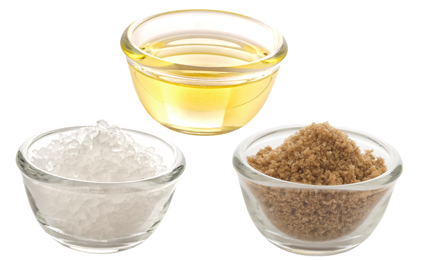Sodium, sugars, and saturated fats are the three S’s often talked about by health professionals, government agencies, and the media, because when consumed in excessive amounts, they present dangers to our health. Let’s break them down one by one.
Sodium
Sodium is an electrolyte essential for our bodies—but in moderate amounts. Excessive sodium intake can lead to high blood pressure (also called hypertension), which increases the risk of heart disease and stroke. The 2015 Dietary Guidelines recommend that most Americans consume no more than 2300 mg of sodium per day, equivalent to one teaspoon of table salt. This limit is lowered to 1500 mg per day for certain populations. (Talk with your doctor or dietitian about how low you should limit your daily intake.) However, 9 out of 10 Americans consume at least 3400 mg daily. Excessive sodium intake is largely coming from foods purchased from retail stores, as well as from restaurants and to a lesser extent, home cooked meals. To keep your daily sodium intake in check, try these shopping, cooking, and dining strategies:
- Focus on fresh foods, limiting intake of packaged, pre-prepared foods (i.e., soups, breads, frozen meals, etc.) that are often high in sodium.
- Choose lower sodium dairy and protein foods by choosing milk, yogurt, and fresh meats more often than cheese, deli meats, and processed meats (i.e., sausage, bacon, hot dogs, etc.)
- Read food labels and opt for the foods with lower sodium levels.
- Limit—or eliminate—salt when cooking at home, using instead pepper, herbs, spices, and lemon juice to add flavor without adding sodium.
- Limit or avoid high-sodium condiments such as soy sauce, steak sauce, teriyaki sauce, seasoning salts, and garlic salt.
- Remove the salt shaker from your table to avoid adding additional salt to your meals.
- When dining out, whether at a fast-food or fine dining restaurant, request “no added salt” on your meal and ask for condiments on the side so that you can use them sparingly.
- Visit our Sodium Savvy page to find a variety of restaurant menu items with 750 mg of sodium or less.
Sugar
Sugar comes in various forms—sometimes naturally occurring and sometimes added to foods—and it is known by several names. Glucose is a simple sugar found in almost all foods containing carbohydrates, and it is the predominant component of corn syrup. It is also the form of sugar that our bodies require for fuel. Fructose, also known as fruit sugar, is derived from fruits and honey. Another name for table sugar is sucrose; this sugar is a slightly more complex combination of glucose and fructose and comes from sugar cane. The naturally occurring sugar in dairy products, lactose, is also a combination of simple sugars: glucose and galactose.
Like sodium, sugar should make up a portion of our daily diets—but again, in moderation. About 100 years ago, the average American consumed 15 grams per day of sugar; today, we each consume a daily average of 55 grams! Excessive sugar intake can lead to weight gain and obesity-related conditions, such as diabetes, heart disease, and fatty liver. Excessive sugar intake also negatively impacts the nutritional quality of your diet, as sugar’s empty calories—meaning they provide no nutritional value—take the place of nutrient-dense calories, or calories that also provide vitamins, minerals, antioxidants, and other nutrients. To lower your sugar consumption, try to minimize your intake of added sugars, focusing mostly on getting your ‘sugar fix’ from naturally occurring sugars. Try these tricks:
- Limit your intake of sugar-sweetened beverages, like regular sodas, juices, energy and sports drinks, and specialty coffee drinks, choosing no-sugar or low-sugar options instead.
- Opt for fruit as a sweet treat rather than sugar-laden cakes, pastries, cookies, candies, and frozen treats.
- Look at nutrition facts labels and select foods with lower grams of sugar per serving; pay particular attention to some unexpected sources of sugar, like tomato sauces, fat-free salad dressings, and other condiments.
- Read ingredient lists and look for sources of added sugars, noting that ingredients higher on the list are more predominant in the food.
- Experiment with baking; try substituting fruit-based sweeteners (i.e., applesauce, fruit juice, etc.) for sugar or decreasing the amount of sugar called for in the recipe by up to 25%.
- Enhance the sweetness of foods with spices and flavorings, such as vanilla or peppermint extracts, cinnamon, cardamom, or others.
Saturated Fat
There are a handful of different types of fat in foods—some which are healthy (in moderation!) and some that should be limited and/or avoided. Saturated fat is one of those that should be limited because it increases cholesterol levels, thereby increasing the risk of heart disease and stroke. Saturated fat is solid at room temperature and is most often found in animal products (high-fat meat and dairy foods), some fried and baked foods, and palm and coconut oils. We will go into a deeper discussion on the topic of fats next month, but for now, know that saturated fat is like sodium and sugar in that it is listed on all nutrition facts labels—so you have the power to choose lower saturated fat options! To decrease your saturated fat intake:
- Choose low-fat and fat-free dairy foods, like skim milk, low-fat cheese, and fat-free yogurt.
- Select lean meats by cooking with lean burger, trimming fat from meat cuts, and removing skin from poultry.
- Substitute regular butter with low-fat butter or margarines.
- Keep sweet treats, like full-fat ice cream and baked goods, to a minimum—helping keep sugar intake low, too!

